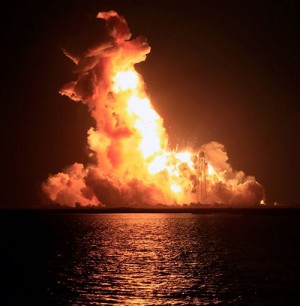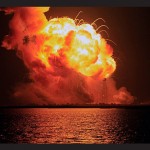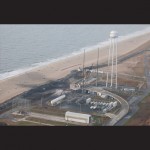
WALLOPS ISLAND — As the anticipation built across the Lower Shore for another significant launch right around dusk on Tuesday, residents and visitors in the area never saw the rocket arch its way across the crystal clear sky, only a pair of loud explosions that shook houses and rattled windows.
Orbital Science’s Antares rocket carrying the Cygnus cargo spacecraft to the International Space Station briefly went up as planned at around 6:22 p.m. on Tuesday, but the mission was aborted just seconds after liftoff when problems with the launch were detected and the rocket exploded six seconds after it left the ground at the Wallops Flight Facility on the Virginia coast just south of Ocean City and Assateague.
Hundreds had gathered to view the highly anticipated launch and around Wallops and along the beaches at Chincoteague and in Ocean City. Hundreds more gathered on porches and decks and backyards across the region for a chance to see the Antares launch, the viewing range for which extended from the Carolinas to New England, but that spectacle never materialized.
The rocket’s flight-termination system, designed to detect anomalies during the launch procedure, engaged shortly after liftoff, causing the Antares to essentially self-destruct and fall back to area of the launch pad. As of Wednesday, it was not certain if the flight termination system was triggered by an automated on-board system or if mission control engaged the system and brought the rocket down.
causing the Antares to essentially self-destruct and fall back to area of the launch pad. As of Wednesday, it was not certain if the flight termination system was triggered by an automated on-board system or if mission control engaged the system and brought the rocket down.
The Antares was an unmanned rocket and no casualties were reported. Shortly after the explosion, emergency services from all over the Lower Shore responded to the area in and around Wallops.
The Antares measured about 131 feet tall and was carrying 5,000 pounds of cargo including food, instruments, experiments and other supplies to the International Space Station. The private-sector Orbital Sciences has a $1.9 billion contract to fly cargo to the space station and Tuesday’s launch was the third scheduled in a series on nine planned launches. The first two were highly successful, and NASA, Wallops and Orbital officials on Wednesday were still trying to sort out what went wrong.
“It is far too early to know the details of what happened,” said Orbital’s Vice President and General Manager of its Advanced Programs Group Frank Culbertson “As we begin to gather information, our primary concern lies with the ongoing safety and security of those involved in our response and recovery operations. We will conduct a thorough investigation immediately to determine the cause of this failure and what steps can be taken to avoid a repeat of this incident. As soon as we understand the cause, we will begin the necessary work to return to flight to support our customers and the nation’s space program.”
For its part, NASA is conducting an extensive investigation into what caused the “catastrophic failure,” as the unsuccessful launch has been characterized, and vowed to move forward with the launch program at Wallops and its partnership with Orbital.

The launch pad area at Wallops Island is pictured on Wednesday, the day after the rocket explosion. Photos by Bob Schwabik
“While NASA is disappointed that Orbital Sciences’ third contracted supply mission to the International Space Station was not successful today [Tuesday], we will continue to move forward toward the next attempt once we fully understand today’s [Tuesday’s] mishap,” said William Gerstenmaier, Associate Adminstrator of NASA’s Human Exploration and Operations Directorate. “The crew of the International Space Station is in no danger of running out of food or other critical supplies.”
Gerstenmaier said NASA remained confident in Orbital’s abilities and expected the company to rebound from Tuesday’s tragedy and move forward with its Antares program.
“Orbital has demonstrated extraordinary capabilities in its first two missions to the station earlier this year, and we know they can replicate that success,” he said. “Launching rockets is an incredibly difficult undertaking and we learn from each success and each setback. Today’s launch attempt will not deter us from our work to expand our already successful capability to launch cargo from American shores to the International Space Station.”
Wallops officials praised the post-launch operations on the ground.
“I want to praise the launch team, range safety all of our emergency responders and those who provided mutual aid and support on a highly professional response that ensured the safety of our most important resource, our people,” said Wallops Director Bill Wrobel. “In the coming days and weeks ahead, we’ll continue to assess the damage on the island and begin the process of moving forward to restore our space launch capabilities. There’s no doubt in my mind that we will rebuild stronger than ever.”
While the investigation is ongoing and will likely take several weeks, federal officials on Wednesday said they remained supportive of the launch activities at Wallops.
“I’m so thankful no one was hurt during last night’s launch failure at Wallops Flight Facility,” said Senator Barbara Mikulski (D-Md.). “It reminds us that rocketry is still hard, but we must try the hard things to continue advancing science and innovation and improving lives along the way.”
Mikulski, who has been a strong advocate for the increased activities at Wallops, said she expected the facility to rebound from the tragedy.
“I remain supportive of Spaceport Wallops and NASA’s commercial cargo mission in achieving America’s independence in transporting supplies to the Space Station,” she said. “I know NASA, Orbital and the Mid-Atlantic Regional Spaceport will work together to evaluate and investigate what went wrong so they can learn from this accident.”
While Tuesday’s mission failed, there is no immediate concern about getting needed supplies to the ISS. A Russian rocket launch to the space station was successfully completed last month and another American launch to the ISS is scheduled from Cape Canaveral in December. Orbital has a $1.9 billion contract with NASA to send nine cargo-carrying rockets to the ISS, but another company, the California-based SpaceX has a similar $1.6 billion contract and is scheduled to make its fourth launch to the ISS in December.
The Antares and its Cygnus cargo vessel along with the supplies represent a loss of about $200 million. By Wednesday, Orbital’s stock had dropped by around 16 percent. On Wednesday, Orbital officials held a conference call with investors and financial analysts to determine the cumulative effect of the loss.
Meanwhile, NASA and Wallops began an initial investigation on Wednesday in the aftermath of the explosion. The initial assessment undertaken on Wednesday is a cursory look and it will take many more weeks to further understand and analyze the extent of the effects. At a quick glance, a number of support buildings in the area immediately adjacent to the launch area have broken windows and imploded doors. A sounding rocket launcher adjacent to the pad and the buildings nearest the pad suffered the most severe damage.
